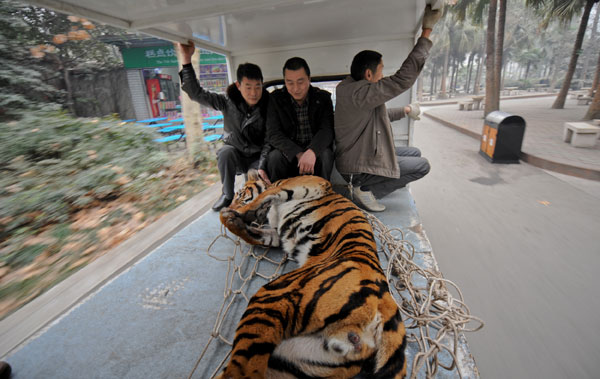Moving day at the zoo a cagey business




 |
|
An anesthetized tiger in Chengdu Zoo of Sichuan province is transferred to a newly furbished home in the zoo. [Photo by Liu Chenping/For China Daily] |
"Animals live in cages that are based on their size and living requirements," Huang said. An animal that lives in water, like a hippopotamus, must be sprayed with water during a move.
An opening at the top of a cage is needed for animals such as giraffes, which can grow to 6 meters. The team transporting a giraffe must choose a route that avoids bridges with low clearings, as well as underpasses. Detours are needed sometimes.
Animal-truck drivers must also avoid steep slopes and driving too fast.
Guangzhou Zoo exchanged one giraffe for another with Kunming earlier this year to prevent inbreeding. The animal was fed mulberry, banyan and bauhinia leaves during the trip, Li said.
He added that bananas and sugar cane are elephants' favorites, hippos like carrots, and rhinos have a taste for carrots and cooked soybeans.
Animals from different areas can have different tastes.
For example, a giraffe from Shandong province came to love green Chinese onions, a local specialty. When it was transferred to a zoo in Beijing, it munched tasty onions all the way.
Xu Linmu, a 75-year-old retired worker from a zoo in Nanjing, Jiangsu province, recalled moving animals nearly 30 years ago, saying, "There was laughter throughout the trip, but it was very exhausting."
He was part of a team taking pandas from Chengdu in Sichuan province to Nanjing. During the two-day trip, team members lived with the pandas in a railway wagon, talking to them and feeding them.
"We became friends," said Xu with a big smile as he recounted the experience.
Animals being transported to zoos in cities can go by truck, ship or plane. Some animals, such as tigers and monkeys, can be transported by air in double-locked cages in the hold.
Cages must be placed well to avoid weight imbalance during a flight, and oxygen must be provided for the animals.
Li, from the animal park in Kunming, said it costs significantly more to transport a giraffe or a rhino than it does a human. "The animals can also be affected by travel sickness in cars or planes, just like humans."
Sometimes, animals are given sedatives to keep them calm and to avoid sickness. On other occasions, when the animals do not have serious vomiting, keepers will talk to them to comfort them.
A zoo must obtain travel permits in advance from the authorities - sometimes even from the central government for protected animals, such as the South China Tiger, said Huang from Guangzhou.
Hu Chunmei, who works for a non-governmental organization in Beijing whose mission is to protect animals' welfare, said, "There have been many cases involving the illegal transportation of wild animals in recent years."
She suggested that authorities should release regulations detailing the requirements for transporting animals, including facilities and services.












